Author: - Padmini Kumar, Bengaluru
Danseuse and Dance Director of Srinivasa Kala Nilaya.)
Dancing is a universal phenomenon. It reflected from the very beginning of the existence of human body, through actions of daily life such as movement from one place to another, catching hold of things, the struggle for the collection of food and the joy after eating etc. If the above acts are conceptualized and done gracefully it gets an aesthetic touch. As an important and integral part of human creativity it has found an amazing expression all over the world and acquired the status of a most subtle fine art.
This fine art is one amongst the many communication techniques. The basic concept of dance which leads to convey an idea, an emotion or a situation to the spectators through the coordinated gestures of the body is called ABHINAYA. The Natyashastra which explains a great deal on the aspect of dance consists of representation (abhinaya).1 This is broadly classified into Angika, Vachika, Aharya and Satvika. ANGIKA is the expression by the use of limbs. Angika-abhinaya is divided into padartha-abhinaya(expression of word to word meaning) and vaakyaartha-abhinaya(communication of general idea). Shaka, Ankura and Suchi are the mediums given for their execution2. SHAKA, meaning branch, indicates the availability of an entire system of gesticulation through the hands. ANKURA is their proper usage in Abhinaya and represents the stage in which the preceding idea lingers. SUCHI denotes what is to succeed. If Abhinaya is without the smooth blending of one idea into another, the result becomes abrupt and a forceful reproduction of what has been taught. From the earliest times the art visionaries have always tried to fix codes for the various movements of the limbs, of which, HASTAS (hands), one of the major limbs has always been receiving the greatest importance.
They are classified as NRTTA hastas and ABHINAYA hastas. Abhinaya hasta is further categorized as ASAMYUTA hasta(single hand) and SAMYUTA hasta(combined hands).The movements of the hands in abhinaya depends on the Shastras(science) which initiates in provoking thoughts and providing scope for further thinking as one studies it.
The dance style of Bharata only is to be understood as MARGA3 tradition that which is contained in Natyashastra. This style coexisted with the DESI4 technique. Down the line especially beyond 10th century, as changes crept into the dance scenario the Desi technique took deviation giving rise to several dance forms. Innumerable treatises that came into existence were known as Desi tradition. Some of the texts that followed suit were Sangita Ratnakara by Sharngadeva, Manasollasa by King Someshawara, Nrtta Ratnavali by Jayasenapati, Nrthyaadhyaaya by King Ashokamalla, Abhinaya Darpana by Nandikeshwara, Hasta Muktavali by Shubhankara Kavi, Nartana Nirnaya by Pandarika Vittala etc.
There may be many authors for various kinds of hastas and the usage might also be varied but the great sage Bharathamuni is the true originator. The study of various treatises on dance authored by knowledgeable scholars will be fruitful as one can have a variety in actions, gestures and movements with a touch of novelty within the frame of shastras. The performance which would last for hours at a stretch in age old days has presently been limited to less than two and a half hours due to time constraints. The need of the hour is crisp presentation and to be precise in gestures. The knowledge of availability of more hastas in treatises of different centuries would help one to be apt in abhinaya.
In dance, from the wrist to the tip of the middle finger counts as hand5. The hands are important in dance as one can express un-definable thoughts and strengthen the ideas to be depicted. The meaning of the theme or the concept can be communicated by using the various hastas according to the requisites of a situation. For this the 12 hasta pranas i.e. the way of using the hands in traditional styles mentioned in Abhinaya Darpana and the hasta kshetras i.e. the regions of the body where hands are placed come to aid.
Desi Dance Form – Bharathanatya
Bharatanatya, about 8 to 9 decades have passed by since this nomenclature was introduced. This was christened Sadir earlier which also had a past of only about 150 to 200 years. This was ruled by oral tradition and still continues to be so. The name was changed to erase the taboo and to gain for it a social acceptance6. This dance is elevated to the classical status. This, a contemporary dance, roots itself in the ADAVU principle which is a basic unit of dance.
In the text Sangita Saramrta of King Tulaja of as late as 18th century the term adavu and its classifications are mentioned but as no diligent search is done in this area it cannot be ascertained if the same adavu techniques are followed now.
Today, a Bharatanatya Marga (sequence of dance items in a recital) commences with the rhythmic utterances of voice and drum in the invocation called the Alarippu, followed by Jatiswara, Shabda, Varna, Padas, and culminates in a gay Tillana. As for practical performance of Bharathanatya, the dances chosen are based on Nrtta and Nrtya divisions. Nrtta here means devoid of thematic presentation like the alaripu and jathiswara. Nrtya for all purposes leads to thematical portray like a Pada.
Taking Bharatanatya as a language, there are the basic Hastas as Alphabets7. Then there are the viniyogas of each hasta as words. These words now constitute to form sentences. The viniyogas form the necessary grammar for performing the dance and are like the foundation of a structure. With different permutation and combination of hastas, combined with artistes’ own skill, one can delineate and interpret any idea. Bharathanatya uses the hastas given in the text Abhinaya Darpana under the categories of Asamyuta, Samyuta and Nrtta hastas. The Nrtta hastas are picked up from both the Abhinaya hastas.
With the idea of getting novelty into Bharathanatya Marga by a variety of hastas, it is required to reach various unexplored treatises along with the basic treatises popularly in use.
The search has been taken up with the prime objective to technically enhance the hasta language of Bharathanatya with the background of the study of hastas in additional treatises and analyze their implementation at the right context in Bharathanatya. Further to create awareness of the vastness of Hasta-abhinaya according to the shastras. A comparative analyses of hastas in all the treatises taken up for the study is to be brought forth. Finally, it is to be made available to be used as a comprehensive guide at a glance.
Methodology of the Study
For this purpose a triple approach method is adopted. The variety in the range of hastas mentioned in the shastras are analyzed. The three treatises employed for the purpose are dealt in chronology of their composition like the Sangita Ratnakara (12th C AD), HastaMuktavali (14th C AD) and Nartananirnaya (16th C AD). There are many more hastas in other treatises like the ones mentioned earlier. This search is limited to the three texts named above. The treatises explored for the study are given comparative treatment. Prior to the above texts, the hastas in the treatises Natyashastra and Abhinaya Darpana are studied in detail. The study is also based on the practical performances of Bharathanatya which is again one of the primary sources.
Limitation
Nrtta hastas in Abhinaya Darpana are only refered here, as the study of hastas is in relation to application in Bharathanatya. The scope of applying 30 Nrtta hastas of Natyashastra has not been adopted in the contemporary Bharatanatya. The texts taken up for study too follow Natyashastra with reference to Nrtta hastas for the most part of it with the same number of Nrtta hastas in Sangita Ratnakara, 27 in Hastamuktavali and 32 in Nartananirnaya. Hence the study of Nrtta hastas in these texts are outside the perview of the subject.
Since the study deals directly with the original treatises, they are the primary sources. The treatises taken up for the purpose are:
The technicality of the hastas in accordance with the treatises taken up for the study is not detailed here as it would be only a repetition of the original texts. The technical knowledge of the hastas envisaged with reference to the treatises normally not used have availed the comparative study of the hastas.
Technical Comparison
Comparative Treatment of Asamyuta Hastas According to Various Treatises : Bharatha described 24 asamyuta hastas while Nandikeshwara added five more, thus raising the total in Abhinaya Darpana to 28. Sangita Ratnakara follows Natyashastra of 24 asamyuta hastas. According to another opinion, Sangita Ratnakara has one more asamyuta hasta i.e. Nikunchaka. Hastamuktavali agrees with Natyashatra with 24 asamyuta hastas, including Urnanabha, to which are listed six more, adding it to make a complete of 30 hastas. They are Kadamba, Krsnasaramukha, Ghronika, Simhasya, Ankusha and Tantrimukha.
Nartananirnaya enumerates 38 asamyuta hastas in all, of which, 24 are similar to Natyashastra and the remaining mentioned here are as thus: Gomukha, Nikuncha, Panchanana, Chaturmukha, Trimukha, Dvimukha, Ranagrdhra, Khadgasya, Alapadma, Skhalita, Mayura, Krodasya, Kakatunda, Balachandra.
Comparative Treatment of Samyuta Hastas According to Various Treatises : Natyashastra enlists 13 samyuta hastas. Abhinaya Darpana takes only eight of these but includs 15 more hastas and The Mirror of Gesture adds Avahittha making a total of 24 hastas. Sangita Ratnakara follows Natyashastra in the number (i.e. thirteen) and names of samyuta hastas. Another opinion enumerates Dvishikhara hasta making a total of 14 hastas. Hastamuktavali enlists the same 13 samyuta hastas of Natyashastra and includes ‘Marala’ totaling it to 14 hastas. Nartananirnaya has a list of 17 samyuta hastas of which 13 are that mentioned in Natyashastra. Shrnkhala, Dardura, Yogamushti and Dwishikhara are the other hastas.
Compatative Treatment of Each of the Asamyuta Hastas in the Treatises : The following are the comparison of each hasta in different treatises. The order of the hastas followed here is that given in the Sangita Ratnakara, and for the remaining hastas the order according to other treatises are followed in this order – Hastamuktavali and lastly Nartananirnaya.
PATAKA – Pataka hasta is defined in a similar way in all the treatises. It is not only the first but also the most important one.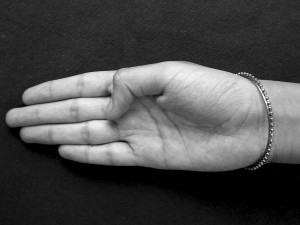
TRIPATAKA – All the treatises agree upon the same definition in the formation of this hasta.
KARTARIMUKHA – Kartarimukha is the name in all treatises. Nartananirnaya calls it Kartari. The definition in all the treatises are similar. Hastamuktavali has two versions – one similar to the others and the second says that the little and the ring finger are gripped into the fist with the thumb, and fore and middle fingers stretched and separated. Of the two, one that befits a particular situation is to be applied. The verse of the 2nd variety is as thus.
Kaniśṭhānāmikānguśhṭhāstale muśhṭῑkṛtā yadi
Madhyamā tarjanīyuktāpyavaktrā kartharīmukhaḥ9
ARDHACHANDRA – The definition is similar in Sangita Ratnakara and Nartananirnaya. In Hastamuktavali with the same formation the fingers are bent in their places looking like a bow. The second version in Hastamuktavali is formed when the mid, ring and little fingers are in the fist and the forefinger and the thumb are spread out.
ARALA – No treatise agrees with the definition with one another and hence there are different formations.
SHUKATUNDA – All the treatises agree upon the same definition from the point of view of their Arala hasta formation.
MUSHTI – Sangita Ratnakara speaks of thumb to be placed on the mid finger. Hastamuktavali speaks of thumb on all the fingers and is named Mushtika. Nartananirnaya defines it to have thumb covered by all the fingers.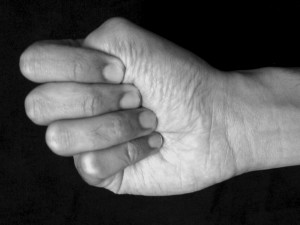
SHIKHARA – Definitions do not vary in any of the treatises.
KAPITTHA – All treatises approve on the same definition
KHATAKAMUKHA – All authorities have opined differently on the definition of this hasta giving different formations.
SUCHYASYA (SUCHIMUKHA) – Each treatise defines this hasta differently. Sangita Ratnakara and Nartananirnaya have named it Suchimukha. Abhinaya Darpana calls it Suchi hasta. Hastamuktavali has it as Suchyasya.
PADMAKOSHA – Same definition is mentioned in all the treatises.
SARPASHIRSHA – Sangita Ratnakara and Nartananirnaya mentions it as Sarpashiras. Hastamuktavali knows it as Sarpashirah. The definition is same everywhere of making a hollow in the palm of the pataka hasta. Only in Nartananirnaya the midfinger of Pataka is bent.
The original verse is as follows:
Patāko nimṛmadhyo yaḥ sa tu sarpashirāḥ karaḥ10
MRIGASHIRSHA – Nartananirnaya opines differently in definition, while rest of the texts share the same definition. According to Nartananirnaya, while the fore finger and the little finger are extended, the tips of thumb and ring finger are joined with midfinger occupying the intervening space. The formation of Gomukha hasta mentioned third in this treatise has the formation of mrgashirsha hasta.
KANGULA – Sangitaratnakara and Hasta Muktavali define differently. In Nartananirnaya the thumb from ring finger of Mayura is separated.
ALAPALLAVA – Definitions do not vary in the various texts. The name is Alapadma in Hastamuktavali. Sangitaratnakara names it Alapallava. Nartananirnaya has two hastas. The same definition for both hastas except that Alapallava has palm turned sideways and Alapadma is opposite of the former in hastakarana.
CHATURA – The definitions are same in all, except it varies in the placement of the thumb. Sangita Ratnakara places its thumb at the middle of the midfinger, while Hastamuktavali and Nartananirnaya has it at the base of the midfinger.
BRAHMARA – In all the texts the common factor is that of the joining of the tips of the midfinger and thumb. In Sangita Ratnakara the forefinger is bent occupying the intervening space of thumb and midfinger, in Nartananirnaya the forefinger is bent slightly, while it is not bent in Hastamuktavali. The second version in Hastamuktavali is – with the mid and the thumb held pressed, little finger raised while the remaining two fingers are moved down and the whole hand is shaken. This is known to be Chalana-madhukara hasta.
HAMSASYA – Sangita Ratnakara and Hastamuktavali share the same definition that the first three fingers held together while the last two are stretched out. Nartananirnaya fills the midfinger in the intervening space between the thumb and the forefinger.
HAMSAPAKSHA – The formation of the hasta is same in all the texts though defined differently.
SAMDAMSHA – The texts are of the same opinion regarding the definition with the thumb and the forefinger striking each other, while the palm is also hollowed in Sangita Ratnakara.
MUKULA – The formation of the hasta is same according to the definitions in all the treatises, though they are worded differently.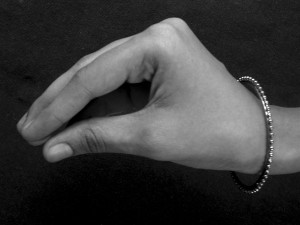
URNANABHA – Though worded variedly gives same formations in all the treatises.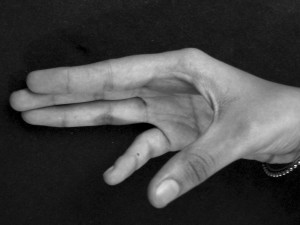
THAMRACHUDA – The definitions in all the treatises are similar though framed differently and the ultimate formation of the hasta is the same.
NIKUNCHAKA – This hasta is found only in Sangita Ratnakara and Nartananirnaya. Definitions are differently framed, but mean the same. The formation is the same. Nartananirnaya names it Nikuncha.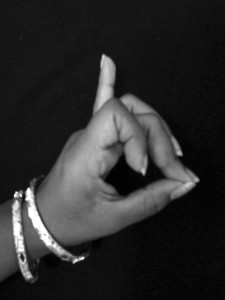
SIMHASYA- It is called so in Hastamuktavali. In Abhinaya Darpana it is known as Simhamukha. The definitions and the formations vary.
MAYURA – This has place only in Nartananirnaya and Abhinaya Darpana with same definition and formation.
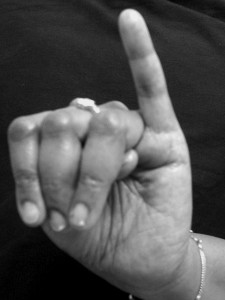
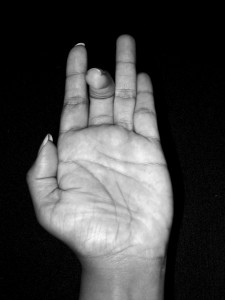
Comparative Treatment of Each of the Samyuta Hastas in the Treatises
ANJALI – This hasta has been defined by all authorities to give the same meaning and same form.
KAPOTA – The meaning of the definitions in all texts are same, so also the form and indicates a dove. The second name given by Sharngadeva in his treatise is Kurmaka.
KARKATA – This hasta has been opined by all authors to give the same meaning and form.
SVASTIKA – Definition in Hastamuktavali is of two arala hastas being crossed at the wrists on the left side. Nartananirnaya mentions of pataka hasta crossed at the wrists. Sangita Ratnakara states the usage of both the above styles.
KATAKAVARDHAMANAKA – Sangita Ratnakara and Nartananirnaya have the same definition of two katakamukha hastas crossed at the wrists. Shubhankara Kavi only mentions of two katakamukha hastas and not indicating how it is to be held in Hastamuktavali.
UTSANGA –Sharngadeva gives as many as four alternative ways of placing the aralas to depict utsanga, beside citing the opinion of some people to substitute Sarpashirsha for arala. According to Shubhankara Kavi, two arala hastas are held upright stretched out in the front, palms facing upward. Pandarika Vittala opines each of two arala hastas to be placed at the opposite shoulders.
NISHADA – Sangita Ratnakara and Nartananirnaya define in a similar pattern i.e. when mukula in one hand is surrounded by the kapittha in the other, nishada takes shape. According to Hastamuktavali the elbows are clasped by the opposite hands.
DOLA – Sangiata Ratnakara variantly read it both as dola and dolaa. Sangita Ratnakara would have all the fingers remain loose. In Hastamuktavali, after letting patakas down, palms are shaken. Nartananirnaya calls it dola and gives a complete different definition. Dola is formed by two pataka hands, palms upturned and joined together.
PUSHPAPUTA – Same definition prevails in all the texts of two sarpashirsha hands joined at the sides.
MAKARA – Sharngadeva and Shubhankara Kavi share the opinion on the formation of this hasta by stating that two patakas placed one over the other with two thumbs extended upwards. The Assamese version of Hastamuktavali suggests the placing of right pataka over the left. Nartananirnaya has two ardhachandra hastas instead of patakas.
GAJADANTA – According to Sangitaratnakara, each hasta is held midway between the opposite shoulder and elbow, but also cites a second opinion, according to which the two hastas facing each other are bent at the elbows towards respective shoulders. Hastamuktavali has two sarpashirsha hastas stretched to the front with bend at the elbows. Nartananirnaya has its two sarpashirshas placed at the opposite elbows.
AVAHITTHA –Although all the texts mention of two shukatunda hasta they are held in different positions. Two solapadmas are placed at the chest according to The Mirror of Gesture.
VARDHAMANA – Sangita Ratnakara and Nartananirnaya have the same definitions with two hamsapakshas placed back to back. Two mrgashirshas are combined in the front according to Hastamuktavali.
DVISHIKHARA – This hasta has mention only in Sangita Ratnakara and Nartananirnaya. While both state that two shikharas are joined, Nartananirnaya extends by citing that they face upwards at the tips.
MARALA – This hasta is mentioned only in Hastamuktavali.
SHRNKHALA- Mentioned in Nartananirnaya only.
DARDURA- Stated only in Nartananirnaya
YOGAMUSHTI- Cited only in Nartananirnaya.
The Nrtta hastas in Abhinaya Darpana are five picked from Asamyuta Hasta and eight from Samyuta Hasta.
Patāka swastikākhya śca ḍōlāhasta-stathānjaliḥ
Kaṭakāvardhana-ścaiva śakaṭaḥ pāśa-kīlakou
Kapitthaḥ śikharaḥ kūrmō haṁsāsya-ścalapadmakaḥ
Trayōdaśaitè hastāssyuḥ nṛttasyā-pyupayōginaḥ11
Here Asamyuta hastas are Pataka, Kapittha, Shikhara, Hamsasya and Alapadma. The ones taken from Samyuta hasta are Svastika, Dola, Anjali, Katakavardhana, Shakata, Pasha, Kilaka and Kurma.
The Nrtta hastas given in Abhinaya Darpana only are used practically by all in Bharathanatya presently. But, all the thirteen nrtta hastas enlisted in Abhinaya Darpana are not in use. They are Shakata, Pasha, Kilaka, Kurma, Hamsasya and Svastika hastas. Some hastas which are traditionally used, but, find no mention in the text under Nrtta hastas are Tripataka, Kartarimukha, Mayura, Ardhachandra, Mushti, Katakamukha, Suchi, Mrigashirsha, Charura and Thamrachuda.
Though Natyashastra is the foundation treatise for all other treatises on dance there are limitations when it comes to usages of hastas. This is benefited by using the additional hastas provided in Sangita Ratnakara with two more abhinaya hastas, Hastamuktavali with further seven hastas along with a heap of usages for each hasta available for abhinaya and Nartananirnaya bestowing fourteen more abhinaya hastas. For all practical purposes in Abhinaya, the treatise referred to is Abhinaya Darpana in which twenty more different hastas are available for use. Abhinaya Darpana is the only text which is supportive for hastas that makes it easy to depict the various Devas, Dashavatara, Caste, Gods of eight directions, relationships etc. as hastas are very clearly defined.
All the treatises give the viniyogas or usages for each hasta except Nartananirnaya. According to Pandarika Vittala, there are infinite number of other hand poses for abhinaya and they should be adopted by the learned from the world.
deśaṁ kālaṁ prayogaṁ ca artayuktimavékśya ca
hastāḥ sarve prayoktavyā nṛbhiḥ strībhirviṡéśataḥ8
The above verse means all these hand poses must be employed with attention to the province (country), the time (nature and spirit of) the performance (or usage) and the context of meaning by men and women.
Hastas in Application in Bharathanatya
Each classical dance tradition of India has its own individuality, history and development. The episodes, themes and ideas they portray, appear to be similar, though the performances are in diverse forms. To express the thoughts through the medium of dancing, this classical art of communication has formed a systematic and properly codified theory and practice. These concepts are very well brought out in the ancient treatises. The various classical dance forms of India follow, apart from the basic treatises, different texts based on their respective regions from where the dance forms originated.
According to various treatises dance has two divisions – Nrtta and Nritya. NRTTA is intricate abstract dance consisting of stylized movements and poses which are devoid of dramatic content. The major constituents are the Tala (the time measure) and Laya (the basic rhythm and tempo). It describes the movements of the body. In Nrtta, the hastas used are only for decorative purpose. They only serve to inculcate grace and variety and do not convey any meaning. Adavus are prominent in Nrtta as also the basic unit of Bharathanatya. Sthanaka, Nrtta hasta, Hasta kshetra and Chaari are the four features of an Adavu. This is a non-thematic form of presentation.
NRITYA is replete with all forms of Abhinaya including Satvika which brings out the inner emotions, beautiful in all its components and attractive to the whole world. It is suggestive, expressive and interpretative dance, with every movement and gesture embedded with meaning. To convey an idea it is sashayed through facial expressions along with the usage of hastas. Thus, it is a thematic presentation.
It is a happy augury that there is a wind of change and the novelty blowing in the field of dance for the artistes who are bored with monotonous and repetitive styles. There are innovative experiences and attempts for bringing freshness. Bharatha’s Natyashastra and Nandikeshwara’s Abhinaya Darpana are the two old pillars giving support to the Indian Dance and in fact they also remain eternally new in this arena. Even so, the other textual traditions are to be explored for giving additional sustenance.
There is quality in novelty to entertain the sahrdayas who are demanding a wave of change. Even in the Marga of Bharathanatya, there are new entries; with pieces like Ashtapadi, Keertanam, Jaavali, Devaranamas, Bhajans and Antahpuragite, series of songs by kannada poet D.V.Gundappa on the madanikes in the temples of Belur and Halebid. Similarly to get diversity into the pieces in the Bharatanatya programme, to make it more attractive, suitable and precise there is the necessity to fetch for treatises written by other great scholars.
The following are the examples of using the Abhinaya hastas according to treatises other than Natyashastra.
Hence, the uses of these hastas are numerous and can be appropriately denoted. Some rare hastas are also found in non-thematic dance like the Pralambha, Kulchipataka and snapping of the thumb and the midfinger. Sophisticated looking Katakamukha hasta of Natyashastra is adopted by a very few dancers.
Conclusion
This work has been prepared in the hope that it may be of some help in formulating a creative examination of hastas of this ancient art. The aims and objectives referred to in the methodoly section have been ascertained. Hastaabhinaya in Bharathanatya has been augmented by fetching it from unexplored treatises along with the usual ones. The hastas have been analyzed as they are available in the diverse texts and have been compared as regards their names, definitions and forms.
As Adavu is the basic unit of Bharathanatya, and hastas in the treatise Abhinaya Darpana are represented for this dance form, Nrtta hastas appearing in this text only are mentioned along with some hastas made use of traditionally. A few hastas which are officially given in the treatise as nrtta hastas have been practically not used but could be adopted occasionally for the purpose of variety. Some rare hastas not listed under the nrtta hasta category in Abhinaya Darpana are made use of traditionally for beauty. This can be used as a ‘guide reference at a glance’ for hastas in the three treatises procured for the study. It has made available the use of additional hastas to the right context. One can easily grasp the full picture of this work. Needless to say that one needs to practice to perfect it.
The comparative study has broughtforth the knowledge of how each hasta has been detailed in the same or varied manner in each of the treatises. Only a few models of the many usages of varied hastas are given in this work. But one can take guidance from the elucidation in the Treatises enumerated in this work for projecting dance for old and new lyrics. There are more abhinaya hastas not exampled here that can be ventured into new choreographies and projections. But a thorough investigation of the theme and understanding of the lyrics is a must.
The hastas not used as per shastras should be aptly made use of to promote its richness and divine value. One should explore the shastras and employ rarely used hastas according to the context to depict a theme aptly.
With the rapid social and economic changes, the traditional dances are being neglected. Though the gap between the traditional dance and new forms are widening, Bharathanatya still continues to hold its own against the tide of dance productions and ‘variety dances’ on stages, films, with their mixture of styles and techniques.
The process of constantly revitalizing the tradition by either reviving older forms or by introducing new forms has kept Bharathanatya vital and healthy. Being a dynamic art one cannot expect it to remain unchanged12. Changes in repertoire are inevitable and should be welcome. It is thus a universal art. As long as man can feel, as long as he can pray and think, this divine art will continue to live and capture the hearts of millions.
There is a famous kannada poem ‘Mankutimmana Kagga’ where the poet says ‘A tree is worth a while if its roots are old and has tender leaves.’ The new choreographies in dance should be creative and open to innovations reaching ‘out of the box’ texts which are ancient and acceptable for fragrance of dance to spread widely and last longer.
Tradition is not a hindrance, but a help in the progress of art. Bharathanatya, the surviving form of traditional dance in India offers the true basis for further progress, unlimited in possibilities for those who are sincere disciples of this dance art.
Foot Notes
BIBLIOGRAPHY
Primary Texts:
Secondary Sources:
This article presented as dissertation for MFA in Bharathanatya and as a research paper was presented on 15th February, 2013- the post lunch session- at Dance Research Conference conducted by Noopura Bhramari Dance Research Forum .
Sincere thanks to Dr. Shobha Shashikumar, veteran danseuse, lecturer/guide for dance studies, resource person and a dance Guru for guiding this study; Dr. M. Udaya Kumar Maiya, Clinical Oncologist, Bangalore for photography; the editor and committee members of Noopura Bhramari for the editing and publication.